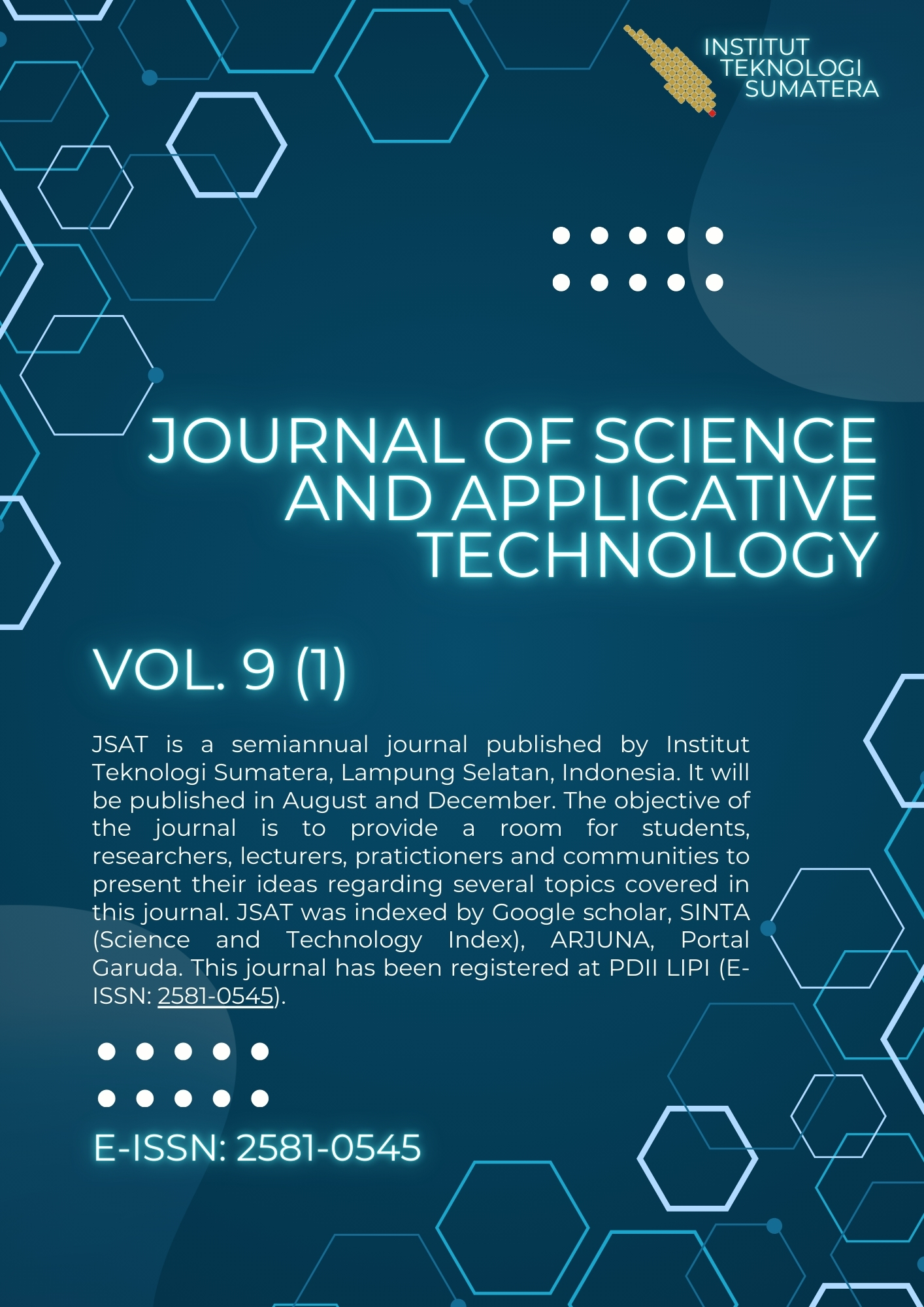Mineralogical Characteristics and Critical Stress Variation in Rock Samples from Bukit Kunyit, Bandar Lampung
Abstract
Mineralogy is essential for understanding rock formation processes and their physical properties, including critical stress. Critical stress values can be estimated using unconfined compressive strength (UCS) measurements, which depend on the modulus values of the minerals present. This study explores the mineralogical characteristics of rock samples from Bukit Kunyit, Bandar Lampung City, and Lampung through X-ray diffraction (XRD) and petrographic analysis. Macroscopic observations revealed two visually distinct rock samples: one with a bright color (Sample 1) and another with a darker hue (Sample 2). Despite these color differences, XRD analysis showed that both samples have the same mineral composition, including Anorthoclase, Cristobalite, Tridymite, and Muscovite, indicating a felsic (silica-rich) nature. Differences were noted in the crystallographic forms of Muscovite and Quartz content, with Sample 2 having a higher Quartz concentration. These mineralogical variations correlate with the observed differences in critical stress, with Sample 1 exhibiting a lower critical stress (20.98 MPa) than Sample 2 (35.05 MPa).
Downloads
References
[2] G. Eroğlu and A. Çalik, “Relationship of petrographic and mineralogical characteristics with mechanical strength properties of granitic rocks: a case study from the Biga Peninsula, NW Turkey,” Turkish J. Earth Sci., vol. 32, no. 1, pp. 126–143, 2023, doi: 10.55730/1300-0985.1831.
[3] R. del Potro and M. Hürlimann, “The decrease in the shear strength of volcanic materials with argillic hydrothermal alteration, insights from the summit region of Teide stratovolcano, Tenerife,” Eng. Geol., vol. 104, no. 1–2, pp. 135–143, 2009, doi: 10.1016/j.enggeo.2008.09.005.
[4] S. Uhlemann et al., “Landslide characterization using P- and S-wave seismic refraction tomography — The importance of elastic moduli,” J. Appl. Geophys., vol. 134, pp. 64–76, 2016, doi: 10.1016/j.jappgeo.2016.08.014.
[5] D. Wu, B. Li, J. Wu, G. Hu, X. Gao, and J. Lu, “Influence of Mineral Composition on Rock Mechanics Properties and Brittleness Evaluation of Surrounding Rocks in Soft Coal Seams,” ACS Omega, vol. 9, no. 1, pp. 1375–1388, 2024, doi: 10.1021/acsomega.3c07731.
[6] S. Salimzadeh, E. D. Hagerup, T. Kadeethum, and H. M. Nick, “The effect of stress distribution on the shape and direction of hydraulic fractures in layered media,” Eng. Fract. Mech., vol. 215, no. April, pp. 151–163, 2019, doi: 10.1016/j.engfracmech.2019.04.041.
[7] T. Nghipulile et al., “Effect of mineralogy on grindability - A case study of copper ores,” J. South. African Inst. Min. Metall., vol. 123, no. 3, pp. 133–144, 2023, doi: 10.17159/2411-9717/1714/2023.
[8] R. M. Tuzingila, L. Kong, and R. Koy Kasongo, “A review on experimental techniques and their applications in the effects of mineral content on geomechanical properties of reservoir shale rock,” Rock Mech. Bull., vol. 3, no. 2, p. 100110, 2024, doi: 10.1016/j.rockmb.2024.100110.
[9] S. Narimani, S. M. Davarpanah, L. Kovács, and B. Vásárhelyi, “Variation of Elastic Stiffness Parameters of Granitic Rock during Loading in Uniaxial Compressive Test,” Appl. Mech., vol. 4, no. 2, pp. 445–459, 2023, doi: 10.3390/applmech4020025.
[10] Y. Qiao, Z. X. Zhang, and S. Zhang, “An Experimental Study of the Relation between Mode I Fracture Toughness, KIc, and Critical Energy Release Rate, GIc,” Materials (Basel)., vol. 16, no. 3, 2023, doi: 10.3390/ma16031056.
[11] V. Donev, O. Lahayne, B. Pichler, and L. Eberhardsteiner, “Ultrasonic characterisation of the elastic properties of mineral aggregates used in asphalt mixtures,” Road Mater. Pavement Des., vol. 25, no. 1, pp. 1–22, 2024, doi: 10.1080/14680629.2023.2188090.
[12] S. Mangga, T. Suwarti, and S. Gafoer, "Peta Geologi Lembar Tanjungkarang, Sumatera, skala 1: 250.000," 1993
[13] A. Lamur, Y. Lavallée, F.E. Iddon, A.J. Hornby, J.E. Kendrick, F.W. Von Aulock, F.B. Wadsworth, “Disclosing the temperature of columnar jointing in lavas, Nat. Commun., 9, 1432,” 2018.
[14] M. R. Setiawan, M. Iqbal, and R. N. Siregar, “Mineral Analysis in Rocks Using XRD and Petrography,” J. Sci. Appl. Technol., vol. 2, no. 1, 2019, doi: 10.35472/281459.
[15] M. R. Setiawan and R. N. Siregar, “Kandungan Mineral dan Struktur Kristal Batu Sekis,” Sci. Phys. Educ. J., vol. 4, no. 1, pp. 24–30, 2020, doi: 10.31539/spej.v4i1.1513.
[16] A. Setiabudi, A. Hardian, and A. Muzakir, Karakterisasi Material; Prinsip dan Aplikasinya dalam Penelitian Kimia. Bandung: UPI PRESS, 2012.
[17] W.-Q. Xie, X.-L. Liu, X.-P. Zhang, Q.-S. Liu, and E.-Z. Wang, “A review of test methods for uniaxial compressive strength of rocks: Theory, apparatus and data processing,” Journal of Rock Mechanics and Geotechnical Engineering, p. S1674775524001914, May 2024, doi: 10.1016/j.jrmge.2024.05.003.
Copyright (c) 2025 Journal of Science and Applicative Technology

This work is licensed under a Creative Commons Attribution-NonCommercial 4.0 International License.
All the content on Journal of Science and Applicative Technology (JSAT) may be used under the terms of the Creative Commons Attribution-NonCommercial 4.0 International License.
You are free to:
- Share - copy and redistribute the material in any medium or format
- Adapt - remix, transform, and build upon the material
Under the following terms:
- Attribution - You must give appropriate credit, provide a link to the license, and indicate if changes were made. You may do so in any reasonable manner, but not in any way that suggests the licensor endorses you or your use.
- NonCommercial - You may not use the material for commercial purposes.
- No additional restrictions - You may not apply legal terms or technological measures that legally restrict others from doing anything the license permits.





















